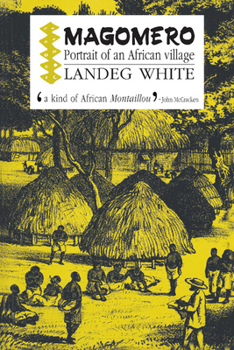Magomero: Portrait of an African Village
Select Format
Select Condition 
Book Overview
Magomero is a vivid historical portrait of a Malawian village from 1859 to the present day. It focuses on a region which saw historically important political activity, in the founding of a colony of... This description may be from another edition of this product.
Format:Paperback
Language:English
ISBN:0521389097
ISBN13:9780521389099
Release Date:September 1989
Publisher:Cambridge University Press
Length:284 Pages
Weight:1.10 lbs.
Dimensions:0.7" x 6.0" x 9.1"
Customer Reviews
1 rating
Best-Written Book by an Africanist Historian {4 1/2 stars}
Published by Thriftbooks.com User , 21 years ago
Now, there's no empirical way to prove the above statement, but given the dominance of social-science conventions in writing on African history, "Magomero" is an obvious front-runner. Landeg White is a gifted literary stylist, and this book often reads like a novel (when someone says that, make sure they're not thinking of "Finnegan's Wake"). It is a study of a village in southern Malawi (colonial Nyasaland) over 100+ years, but it is much more than that too.White's sense of drama is aided by some highly dramatic personages who figure prominently in his story. The most famous is missionary-explorer David Livingstone, a perennially fascinating, complex and influential shaper of the continent's destiny. He visited Magomero, site of the ill-fated Universities' Mission to Central Africa, frequently on two expeditions in the 1850s and 1860s. White perceptively examines the ambiguities of Livingstone's antislavery crusade, not least the paradox of purchasing slaves in order to free them---thus inadvertently stimulating the market. But John Chilembwe is just as interesting: a Malawian Protestant minister and protonationalist who studied in the USA, founded an independent mission, and eventually died leading a doomed rebellion against British rule in 1915. The later chapters are not as event-oriented, but the lucid accounts of cash cropping and womens' work are probably more representative of daily life in the colonial era, and a major contribution to social and economic history."Magomero" does not have detailed source notes (they tend to scare off the mass audience White aims for here), but references to scholars' names without the titles of their works ensure that only specialists can swiftly identify White's sources. The other problem is that the author's own account of villagers' accepting his presence and explanation of his research is awkwardly unconvincing; it would be more credible in the words of Malawians themselves, without assuming that they care about associations with long-dead muzungus (Europeans). These minor faults aside, this is the most enjoyable scholarly book I've come across in nearly 20 years in African Studies. For more on the area's history, see E. Mandala, "Work and Control in a Peasant Economy" and M. Vaughan, "The Story of an African Famine." G. Shepperson & T. Price, "Independent African," a classic on Africa, tells the Chilembwe story with great depth and sensitivity. For an authentic Nyasaland account based on oral data from participants in the Rising, see G.S. Mwase, "Strike a Blow and Die."





